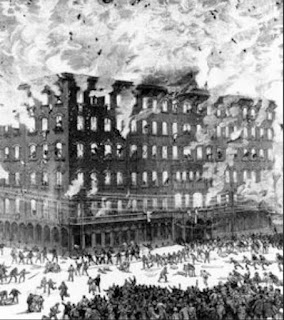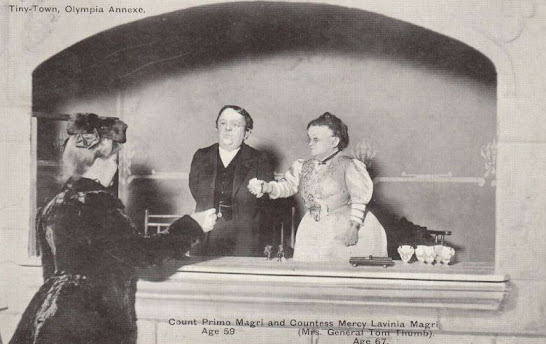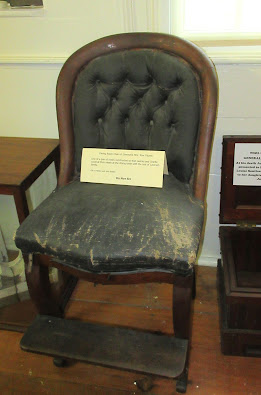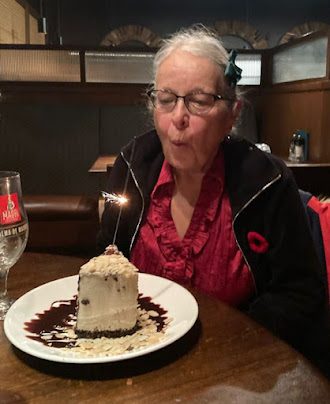#34 MRS. GENERAL TOM THUMB
LAVINIA WARREN
LAVINIA'S CHILDHOOD: Mercy Lavinia (Vinnie) Bump was born October 31, 1841, in Middleborough, Massachusetts, to a family of good standing. At birth she weighed a normal six pounds, but she stopped growing at age 10. In adulthood, Lavinia stood 32 inches tall, weighed 30 pounds and was perfectly formed in every way. All of her siblings, as well as her parents James Bump and Huldah Warren, were normal-size--except for her younger sister, Huldah, called Minnie. (Minnie was even smaller than Vinnie, so was the “smallest women in the world”.)
Both Minnie and Vinnie had a form of proportionate dwarfism, probably caused by a pituitary disorder. (Had she been born in modern times, she would have been given human growth hormones.) But at the time, she (and her future husband, Charles Stratton, aka General Tom Thumb) were highly prized “curiosities” in an America that was just beginning to be linked by railroad, steamships, photography, and newspapers; people could now experience a world outside their own small villages. Most people had never seen, nor really ever heard of, little people. And the fact that Vinnie and Charles and Minnie were “perfectly formed people in miniature, made them palatable and interesting to the public. Sadly, those who had disproportionate dwarfism were, tragically, considered distasteful, and often used in circuses and sideshows to depict savages or idiots.”
Vinnie had a very loving and normal childhood and was hired, at age 16, as a schoolteacher in her hometown. Then a Colonel Wood—supposedly a cousin—showed up at her family home one day with an invitation to appear on his “floating palace of curiosities” out west on the Mississippi.
To the great shock of her pious and protective family, Vinnie leapt at the chance to travel, to see things, to experience a wider world than she could in New England. She had a feeling that her fate, were she to remain at home, would likely have been a dismal one. A woman in mid-nineteenth-century America had few options; either she married, or she remained dependent upon her relatives for the rest of her life. She could not have a career (beyond that of modest schoolmarm) of her own. And it is unlikely Vinnie, or her family ever thought, that given her size, that she would marry. After her cousin’s visit, she now had another option—she could leave Middleborough, travel, have a career and she could do this as a single woman precisely because of her size. While circus “fat ladies” might earn $15 a week, “little people” could earn $100 a week. And this was all because a showman, P.T.Barnum, had just introduced the public to General Tom Thumb; suddenly there was great interest in the “Curiosities” of the world, and Vinnie was quick to avail herself of this opportunity.
GENERAL TOM THUMB: P.T.Barnum first met Tom Thumb in 1842 when the latter was just a precocious boy of eight. His name was Charles Stratton and his father was a drayman. Barnum offered the father $3 a week for the use of the boy and exhibited him in New York City as General Tom Thumb. Barnum billed Tom Thumb as “the smallest man alive” and his performances included singing, dancing and impersonating famous people. Tom grew to 40 inches and weighed 70 pounds.
In 1844 Barnum took Tom to London. Following a performance of comic opera, Tom came on stage singing Yankee Doodle Dandy. Then he entertained the audience dressed as Napoleon, Hercules and Sampson but the act best loved by the crowd was his performance as Cupid, complete with little wings. His reception was not quite up to the adulation earlier in New York, but that changed following audiences with Queen Victoria and the royal court. Then he went on a tour of continental Europe.
perhaps the carriage given to Tom Thumb by Queen Victoria
Tom’s commercial value had increased greatly. The sale of photo picture cards of The General attired in different costumes and uniforms was a very lucrative side business. On returning, the prosperous “General“ built himself a comfortable home in Bridgeport with doll-size furniture and dishes. (He also had a home on Thimble Island off the Connecticut coast and later another in Middleborough, Mass.) He owned a string of race horses and a yacht which he sailed on Long Island Sound.
LAVINIA & P.T.BARNUM: Lavinia spent almost three years on the Ohio and Mississippi showboats. During this time she met notable political figures including Ulysses S. Grant (then a private businessman) and Stephen Douglas (Lincoln's opponent for the Presidency). She suffered a three month life-or-death battle with typhoid fever. "We continued our journeying until after the election in 1860, when the doubts, fears and excitements which preceded the coming of our civil war were being everywhere felt. We were then in the lower Mississippi states. Northerners were looked upon with suspicion; our business fell off." Afraid of being stranded in hostile territory during the Civil War, the showboats were sold, and after many delays, Vinnie and the theatrical troupe escaped north and then she boarded a train home to her parents in Middleborough.
A year or so later, P.T.Barnum “heard” of her and sent an agent to interview her. Barnum described Lavinia as “a most refined and intelligent young lady, well-educated and an accomplished, beautiful and perfectly developed woman in miniature.” Barnum offered her $1000 a week to exhibit herself at his Museum in New York City.
Her parents were skeptical because they didn’t wish to have their daughter caught up in Barnum’s “humbugs.” But somehow, Vinnie and Barnum persuaded her parents to let her go, and it was only a matter of weeks before Vinnie was capturing the hearts of the New York press with her stately levees. She would sing and dance and “speak graciously and charmingly with her fans. She was heralded by all as the Little Queen of Beauty and was earning $3000 a day for the Museum.” It was Barnum who told her to change her awkward maiden surname, Bump, to her mother’s family name, Warren. (The Warrens claimed lineage to the Mayflower.)
Lavinia was described by The New York Times. “She can sew, knit, cook and do all manners of housework. She also has a knowledge of fancy work practised by ladies who have the leisure to devote themselves to it. She is intelligent, pleasant, modest and agreeable. She is very lively in conversation and speaks with all the confidence, and even wit, of an accomplished and talented woman; indeed, she is quite as charming, mentally as she is physically. Her eye is bright, her smile sweet, her hair dark and her figure perfection itself.”
THE WEDDING: It made sense to Barnum, and perhaps to Vinnie, that the Little Queen of Beauty should marry a King and the perfect candidate happened to be right there--Charles Stratton. Barnum’s greatest discovery and greater friend, met Vinnie; for him, it was love at first sight. Barnum wasted no time fanning the flames of love and most importantly the interest of the press,
The New York Times reported: “Tom Thumb looked cheerfully serene in full evening dress; his hair was curled and frizzied; his appearance that of a little man in whom the juices of life were yet rich and whose jolly days were not yet done.” Lavinia’s wedding dress was “made of the richest white satin, with waist pointed in front and behind and laced at the back. It is low necked, with bertha, which is trimmed with point applique. The arm caps are also trimmed with the same costly material. The skirt is box-plaited and bears one flounce of point applique, half a yard in width, and trailing in the most graceful manner. The bridal veil is of the same lace and is made to fall entirely over the dress as low as the bride’s slippers. The slippers are white satin, with rosettes of point lace with buckles of pearl. The marriage gloves are white kid, trimmed with point lace, and are the neatest little articles…The hose…are of white embroidered silk, and the handkerchief is lawn of the finest quality, margined with point applique.” Her jewels attracted much attention. The brooch consisted of a cluster in the form of a star. The earrings were solitaires in pear shaped pendants. The veil was fastened with two diagonal hair pins, with three pendants each. The bracelets matched the brooch and were of star design. The necklace was superb, forming leaves of diamonds, each diamond and accompanying pendant resembling sparling dew drops. The magnificent bridal costume cost $500. (abt 15-$20,000 today)
The sidewalks on Broadway were crowded with spectators (pickpockets were very busy plying their trade.) The police were detailed to preserve order as the guests’ carriages proceeded from the church to the reception at the Metropolitan Hotel. The newly-married couple greeted guests atop a grand piano. Wedding gifts were on display; one gift was a Tiffany miniature silver horse and chariot, decorated with rubies and garnets for the horse’s eyes.
Another gift was an
elegantly carved miniature billiards table with inlaid cues and minute balls. Also
on display was a caramel confectionary tower, fruit, wine, floral bouquets, a
carved easy chair, fans, slippers, charms, a pearl ring, a bird watch, tea set
of 5 silver pieces lined with gold, and silver spoons, castors, nut pickers,
napkin rings, salt cellars, an ermine cape, muff and cuffs, a sewing machine with
ornamental designs in pearl. Mary Lincoln gave a set of Chinese fire screens. P.T. Barnum gave a “most curious mechanism...a
handsomely wrought casket of polished tortoise shell. Upon touching a spring, a
little bird clad in natural feathers rises from within, and sings the sweetest
carols. It shakes its head, and altogether deports itself as any good natured
and eloquent little bird might be supposed to do in company.” Tom gave Lavina, his new bride, an array of
jewels valued at around $10,000.
“Among
those who were present at the reception were representatives of the first
families of this city, and indeed the country. Statesmen and soldiers, divines
and editors, merchants and authors, paid their respects to the happy couple,
who received all with a smile. Altogether the ceremony and reception was
conducted with the best of propriety and good taste. The arrangements were most
ample and most fastidious to which not even the daintiest could take exception.”
This marriage was top news—every paper covered it--and it even relegated the Civil War to the back pages. Many wealthy families of
Fifth Avenue competed to have Tom and Lavinia spend their honeymoon with them “surrounded
by intelligence, beauty and palatial splendor.” Even though it was in the midst of the Civil War,
President Lincoln and his wife held a reception for the new couple at the White
House. The couple intended to then visit Philadelphia and Baltimore prior to leaving
for Europe.
ON TOUR: Vinnie and Charles, along with her sister Minnie, and another little person, Commodore Nutt, began performing together.
The Thumbs performed four times in Ottawa. The 1864 performance included members of the wedding party--The Thumbs, her sister Minnie and their "little" groomsman. The notice advertised that the "four smallest human beings of mature age" weighed a collective 100 pounds. For part of this 1864 show, General and Mrs. Thumb wore their wedding clothes and they exhibited their jewels and other gifts. After their1883 performance, newspapers commented that the General had grown stouter and even though he was very amusing and Lavinia was as charming as ever, they were "getting on age". (Along with the General and his wife, other members of the troupe included dancers, a ventriloquist and a lady whose odd act consisted of "highly educated, trained canaries.")
In 1869, the quartet set out on a world tour that lasted three years and covered 56,000 miles (29,000 miles by sea). They gave 1284 entertainments in 407 different cities and towns, "in all climates of the world, without losing a single performance through illness or accident." They travelled to Japan, China, Singapore, India, Australia (in Australia they logged over 5000 miles and visited 105 Australian towns and cities), Yemen, Egypt, Italy, England. They were among the first passengers on the new US transcontinental railroad. (Indian raids had been reported, so Charles asked to carry firearms, but his manager refused.)
If any person will perform the feat of travelling with such a company 48,946 miles (29,000 miles by sea), let him show his vouchers and I will give him the belt...---a letter to P.T.Barnum 1871
The Thumbs met Queen Victoria, Pope Pius IX, Napoleon III.
tea set given to the Thumbs by Queen Victoria
Though their fame afforded the Thumbs a life of luxury, it came with downsides. They were presented as childless to the public by Barnum; this was an advertising strategy to make the audience feel sympathetic towards them in order to sell more tickets. But due to the way they were presented, people treated them like children. Many people Lavinia met wanted to pet and hold her. She wrote, “It seemed impossible to make people understand at first that I was not a child, that, being a woman, I had the womanly instinct of shrinking from a form of familiarity which in the case of a child of my size would have been as natural as it was permissible.”
BABY THUMB HOAX: A year after the wedding, Barnum quietly released press photos of Charles and Lavinia—with a baby nestled in her arms. It was announced that their child was born on December 5, 1863. The child went on tour with them and was described as very beautiful; a fortune’s worth of pictures of the happy family were sold. Tragically, less than three years later, newspapers reported that Minnie Tom Thumb had died from an inflammation of the brain. Later, in 1901, Lavinia revealed that she had never given birth at any time. She said, “The Exhibition Baby came from a foundling hospital in the first place and was renewed as often as we found it necessary. A real baby would have grown. Our first baby—a boy—grew very rapidly. At the age of four years, he was taller than his father. This would never do. Our friends predicted that our son would be a giant, and that in a few years his parents would look ridiculous alongside him. We appealed to Mr. Barnum. He agreed with us. He thought our
Lavinia, "Baby Thumb" sister Minnie..on tour
LIFESTYLE: Tom and Lavinia lived comfortably and lavishly for the next 20 years, only sometimes appearing at Barnum’s Museum in New York or going on tours. They were happily married but the General was extravagant, spending his fortune on sailing sloops and pedigree horses. Lavinia also had expensive taste—for socializing, for designer clothes, for ermine capes to wear to the theatre, for jewels ordered from London.
In 1878, Vinnie’s beloved sister, Minnie died in childbirth. And suddenly Mrs. and Mrs. Thumb stumbled on hard times. They continued to perform, but tastes were changing, the country was more sophisticated, and their audiences became smaller. Hard-up financially—they believed they had to live the life that their society friends could more easily afford. They even travelled with Barnum’s great circus for a season performing as part of the sideshow. Charles gained height and became quite stout.
CHARLES' DEATH: In 1883, Vinnie and Charles were touring once more, staying at the Newhall House in Milwaukee. They were delighted that the hotel had installed an elevator because they always had difficulty managing staircases; finally they could take an elevator to their room (with a view) on the sixth floor. The hotel caught fire and at least 70 people died; Charles and Minnie were carried down a swaying ladder under the arm of a firefighter.
Charles never recovered from the shock of that experience. Just six months later on July 15, 1883, he died of a stroke (aged 45) in Middleborough, Mass. He is buried in Mount Grove Cemetery in Bridgeport. (P.T.Barnum is buried just a few yards away.)
REMARRIAGE: Vinnie retreated to her childhood home, her finances in ruins. Charles’s estate was now only a few pieces of property and $16,000. She did not have enough savings to retire so Barnum encouraged her to keep going, to keep appearing in public.
In 1885, she married Count Primo Magi, an Italian dwarf, a piccolo player and a pugilist who stood 2 feet, 8 inches (2 inches shorter than Charles). While the aristocratic and military titles that P.T.Barnum gave his dwarfs were fantasy titles, it is claimed that Count Magri was given his title by Pope Pius IX; thus Lavinia became Countess Magri.Magri and Lavinia formed the Lilliputian Opera Company. She continued to tour, even appearing on vaudeville and in early silent movies (The Lilliputians Courtship 1915). Ever short of funds, the couple opened up a roadside ice cream shop near their home, called Primo’s Pastime; they entertained anyone who would stop to buy a souvenir postcard, soda or candy. They also spent a couple of sad summers as part of the “Midget City Dreamland” exhibit at Coney Island. They did occasionally appear in local charity productions. The Countess was a member of The Order of the Eastern Star and a Daughter of the Revolution. For many years, she was a Christian Scientist in faith.
Lavinia & The Count
Lavinia died in 1919, aged 78. She requested that her possessions be given to the town of Middleborough. Magri, however, decided to auction her things so he could return to Italy. The auction netted less than $1000. Magri died in 1920 at Middleborough, Mass., aged 71, a year after Lavinia.
REFLEXIONS: Lavinia had hoped to publish her autobiography but only managed a few incomplete chapters. There is much missing like the death of her sister or the baby hoax. Her writing is really an uninspiring travelogue of places visited and people met. She didn’t discuss her feelings, never shared any disappointments, any frustrations about her size, or her physical discomforts. She made no mention of the humbug she and Barnum perpetrated concerning Baby Thumb or how she felt deceiving the public into rejoicing over the “birth” and then mourning the “death of Baby Thumb". Accounts vary as to whether Lavinia was barren, or that she chose not to have children; but she must have been very aware of the dangers to one her size as she had witnessed the death of her sister, Minnie. in childbirth.
But she did
say “Mr. Barnum was a great man.” It does seem that Barnum was ultimately her
true companion and partner and a soul-mate. P.T. Barnum died in 1891; he
arranged to have his obituary run a few days prior to his death so he could
read it.
Lavinia’s marriage
to Charles—love or fame? Most accounts record their marriage as a happy one,
yet she was well aware of the enormous fame attached to marrying the most
famous little person in the world. The
novelty of the perfect little couple in miniature was too much to pass up. Most
accounts also describe Charles Stratton as an innocent, an intellectual
weakling—although a genial man who would not have caused Vinnie any grief. But
he did not excite her mind like Barnum.
LAVINIA'S DEATH: Lavinia died November 25, 1919 in Middleborough, aged 78; she was buried next to her first husband in Mountain Grove Cemetery, Bridgeport, Connecticut. Charles’ gravestone is an obelisk bearing his name with a life-size statue of himself; hers is a simple gravestone that reads, “His Wife.” Despite her second marriage, she signed her name, until the end of her life, as Mrs. General Tom Thumb.
Charles Stratton grave, Mountain Grove Cemetery, Bridgeport
Lavinia's philosophy of life. "My life has been one of many hardships and deprivation of seeming pleasures in the society of home, yet I felt it my duty to fill my mission as I saw it--providing pleasure and entertainment for men, women and children".
MERCY
LIVINIA BUMP (WARREN)






























































Very interesting history!
ReplyDeleteInteresting read. Owen looks so tall.
ReplyDeleteGlad these stories are being brought to life vs
ReplyDeleteLavinia lived a very adventure-filled life.
ReplyDeleteInteresting story.
ReplyDelete